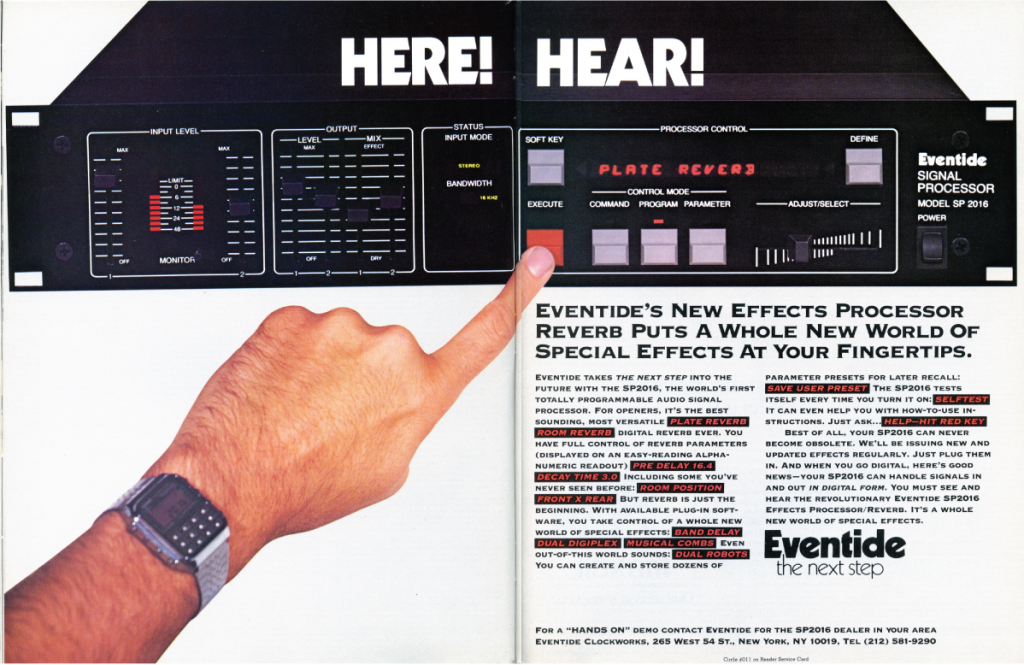In 1979, Tony Agnello had a vision. Up to that point, effect units were dedicated to a single function. There were EQs, compressors, limiters, pitch changers, flangers and phasers, but no box was powerful enough to handle more than a single, simple function. Tony saw the potential of a Digital Signal Processing box that could do much, much more.

Reverbs Without Rooms
In the late 60’s at Bell Labs, M.R. Schroeder had published important research describing the use of comb filters in conjunction with allpass filters to simulate the acoustics of an actual room. Back then, the technology didn’t exist to run even Schroeder’s primitive algorithm in anywhere near real time. By the early 80’s, the technology had advanced and companies like EMT, AMS, Sony, Quantec, Lexicon and Eventide were hot on the trail of creating convincing artificial reverberation. In a short span of time a number of digital reverbs were brought to market; all but one were one trick ponies – reverb and nothing else.
These early digital reverbs required considerable processing power and the designs lived at the extreme state of the art for their time. The cost of these units was also considerable; tens of thousands of dollars in today’s dollars. For example, accounting for inflation, a Lexicon 224 priced at $7,500 in 1979 would cost you $27,000 today – and that’s for one reverb with two programs. This price point was justified due to the fact that, up until this point, reverb had to be physically created by placing a mic in an actual room with a set of speakers and sending audio through it – the ‘echo chamber’ or installing an expensive plate reverb.
The SP2016 On The Scene
Tony realized that a system that could achieve realistic artificial reverb could perform many additional functions. Eventide had been successful in introducing units dedicated to producing effects like delay (the 1745 in 1971), pitch change (the H910 in 1974) as well as phasing and flanging, but those designs predated microprocessors and were necessarily fixed-function. And, they were 100% software free. Realistic sounding reverb required significantly more horsepower than simple delay and filtering; it required complex algorithms coded as software. In other words, a system designed for reverb could be programmed to do so much more.

After years of development, in 1981, Eventide released pro-audio’s first multi-purpose Signal Processor, the SP2016. What was it? It was an ‘array processor’ built using six, 4 bit-slice ALUs running 24-bit fixed point arithmetic, a 16X16 bit Multiplier with 32-bit Accumulator and multiple banks of memory. It was designed to perform multiple operations in parallel and run fast enough to execute reverb algorithms worlds more complex than Schroeder’s simple model. It was a platform that could and did run a damn good reverb. But more than that, it came with a whopping 20 programs and the ability to save user-created presets. It was a reverb; it was a delay; it was a filter; it was a flanger; it was a chorus; it was a multitap delay; it was a ‘timescrambler’; a vocoder; it was whatever you needed it to be.
And if that wasn’t enough, you could install ROM chips with additional effects. You could just take a ROM chip and “plug it in.” The sheer, unprecedented versatility of the SP2016 led to the universality of the buzzword, ‘plug-in’, that we now all know and love. The craziest part of it all? This was years before 1987 when computers first accepted plug-in software.

The last SP2016 was manufactured over 30 years ago, but we were lucky to have a rare, working model in the Eventide lab:
That reverb is glorious – and is also faithfully recreated in the SP2016 emulation, should you be interested in trying it yourself!

The Next Step
The SP2016 enjoyed limited commercial success in part because the industry was not ready for a general purpose device. Digital reverbs were the cool new thing and it was hard for some to wrap their heads around the concept of ‘it can do anything’. And, the names of some of the effects, like vocoder, band delays or timescramble, were new to most audio pros.
With the advent of the DSP chip, the SP2016’s array processor architecture was no longer necessary for real time audio processing and Eventide developed the DSP chip based H3000. The H3000 was such a massive hit in the 90s that the H8000 soon followed, dominating the multi-effects market in the 2000s.
In an article from 1982 titled “Digital Audio Processing – The Next Step”, with DSP chips on the horizon, Tony wrote:
“If we could somehow centralize all the processing power in one general-purpose unit (endowed, of course, with more power than we could ever conceivably require) and exercise total control over its every operation, we would achieve maximum efficiency…This super-processor will doubtless exist someday and in fact is one of the promises of digital audio. Simply stated, the super-processor ensures the optimum use of available resources.”
Imagine if we could take a trip back in time and talk to Tony for a few minutes. Imagine his awe if we told him that our newest product, the H9000, has over 2000 presets, can run 16 DSP algorithms simultaneously, can chain effects together and accept any kind of input imaginable. I doubt that he would be surprised. It appears that he knew what was coming all along…


